A Storable Mediatorless Electrochemical Biosensor for Herbicide Detection
Abstract
1. Introduction
2. Materials and Methods
2.1. Reagents and Solutions
2.2. Synechocystis Culture
2.3. Electrode Fabrication and Biosensor Construction
2.4. Electrochemical Analysis
2.5. Chlorophyll Determination
2.6. Biosensor Storage
3. Results
3.1. Biosensor Design and Photocurrent Production
3.2. Detection of Herbicides
3.3. Bioelectrode Storage and Stability
4. Discussion
5. Conclusions
Supplementary Materials
Author Contributions
Funding
Acknowledgments
Conflicts of Interest
Abbreviations
| CN | carbon nanotubes |
| WE | working electrode |
| CE | counter electrode |
| RE | reference electrode |
| ITO | indium tin oxide |
| Pq | paraquat |
| PS I | photosystem I |
| PS II | photosystem II |
References
- Teixeira, R.R.; Pereira, J.L.; Pereira, W.L. Photosynthetic Inhibitors, Applied Photosynthesis; Najafpou, M., Ed.; IntechOpen: London, UK, 2012; pp. 2–22. [Google Scholar]
- Draber, W.; Fujita, T. Rational Approaches to Structure, Activity, and Ecotoxicology of Agrochemicals; CRC Press: Boca Raton, FL, USA, 1992. [Google Scholar]
- Metz, J.G.; Pakrasi, H.B.; Seibert, M.; Arntzer, C.J. Evidence for a dual function of the herbicide-binding D1 protein in photosystem II. FEBS Lett. 1986, 205, 269–274. [Google Scholar] [CrossRef]
- Sagarkar, S.; Mukherjee, S.; Nousiainen, A.; Björklöf, K.; Purohit, H.J.; Jorgensen, K.S.; Kapley, A. Monitoring bioremediation of atrazine in soil microcosms using molecular tools. Environ. Pollut. 2013, 172, 108–115. [Google Scholar] [CrossRef] [PubMed]
- Hayes, T.; Haston, K.; Tsui, M.; Hoang, A.; Haeffele, C.; Vonk, A. Atrazine-induced hermaphroditism at 0.1 ppb in American leopard frogs (Rana pipiens): Laboratory and field evidence. Environ. Health Perspect. 2003, 111, 568–575. [Google Scholar] [CrossRef] [PubMed]
- Lasserre, J.P.; Fack, F.; Revets, D.; Planchon, S.; Renaut, J.; Hoffmann, L.; Gutleb, A.C.; Muller, C.P.; Bohn, T. Effects of the endocrine disruptors atrazine and PCB 153 on the protein expression of MCF-7 human cells. J. Proteome Res. 2009, 8, 5485–5496. [Google Scholar] [CrossRef]
- E.U. Health & Consumer Protection Directorate General. Review Report for the Active Substance Atrazine; SANCO/10496/2003-final; E.U. Health & Consumer Protection Directorate General: Brussels, Belgium, 2003. [Google Scholar]
- Simões, M.D.; Bracht, L.; Parizotto, A.V.; Comar, J.F.; Peralta, R.M.; Bracht, A. The metabolic effects of diuron in the rat liver. Environ. Toxicol. Pharmacol. 2017, 54, 53–61. [Google Scholar] [CrossRef]
- Giacomazzi, S.; Cochet, N. Environmental impact of diuron transformation: A review. Chemosphere 2004, 56, 1021–1032. [Google Scholar] [CrossRef]
- Al-Khatib, K. Photosystem I (PSI) Electron Diverter, Univ. Calif. (n.d.). Available online: http://herbicidesymptoms.ipm.ucanr.edu/MOA/Photosystem_I_PSI_Electron_Diverter/ (accessed on 4 August 2019).
- Bus, J.S.; Aust, S.D.; Gibson, J.E. Paraquat toxicity: Proposed mechanism of action involving lipid peroxidation. Environ. Health Perspect. 1976, 16, 139–146. [Google Scholar] [CrossRef]
- Seok, S.J.; Gil, H.W.; Jeong, D.S.; Yang, J.O.; Lee, E.Y.; Hong, S.Y. Paraquat intoxication in subjects who attempt suicide: Why they chose paraquat. Korean J. Intern. Med. 2009, 24, 247–251. [Google Scholar] [CrossRef]
- Zaranyika, M.; Nyoni, S. Degradation of paraquat in the aquatic environment: A proposed enzymatic kinetic model that takes into account adsorption/desorption of the herbicide by colloidal and sediment particles. Int. J. Res. Chem. Environ. 2013, 3, 26–35. [Google Scholar]
- Court of First Instance of the European Communities. The Court of First Instance Annuls the Directive Authorizing Paraquat as an Active Plant Protection Substance; Court of First Instance of the European Communities: Luxembourg, 2007. [Google Scholar]
- Zamora-Sequeira, R.; Starbird-p, R.; Rojas-Carillo, O.; Rica, C. What are the main sensor methods for quantifying pesticides in agricultural activities? A review. Molecules 2019, 24, 2659. [Google Scholar] [CrossRef]
- Verma, N.; Bhardwaj, A. biosensor technology for pesticides—A review. Appl. Biochem. Biotechnol. 2015, 175, 3093–3119. [Google Scholar] [CrossRef] [PubMed]
- Marrazza, G. Piezoelectric biosensors for organophosphate and carbamate pesticides: A review. Biosensors 2014, 4, 301–317. [Google Scholar] [CrossRef] [PubMed]
- Campanella, L.; Eremin, S.; Lelo, D.; Martini, E.; Tomassetti, M. Reliable new immunosensor for atrazine pesticide analysis. Sens. Actuators B Chem. 2011, 156, 50–62. [Google Scholar] [CrossRef]
- Liu, X.; Li, W.J.; Li, L.; Yang, Y.; Mao, L.G.; Peng, Z. A label-free electrochemical immunosensor based on gold nanoparticles for direct detection of atrazine. Sens. Actuators B Chem. 2014, 191, 408–414. [Google Scholar] [CrossRef]
- Funari, R.; della Ventura, B.; Carrieri, R.; Morra, L.; Lahoz, E.; Gesuele, F.; Altucci, C.; Velotta, R. Detection of parathion and patulin by quartz-crystal microbalance functionalized by the photonics immobilization technique. Biosens. Bioelectron. 2015, 67, 224–229. [Google Scholar] [CrossRef]
- Teselle, E.K.; Baum, D.A. Isolation of DNA aptamers for herbicides under varying divalent metal ion concentrations. Aptamers 2018, 2, 82–87. [Google Scholar]
- Bala, R.; Kumar, M.; Bansal, K.; Sharma, R.K.; Wangoo, N. Ultrasensitive aptamer biosensor for malathion detection based on cationic polymer and gold nanoparticles. Biosens. Bioelectron. 2016, 85, 445–449. [Google Scholar] [CrossRef]
- Bucur, B.; Munteanu, F.D.; Marty, J.L.; Vasilescu, A. Advances in enzyme-based biosensors for pesticide detection. Biosensors 2018, 8, 27. [Google Scholar] [CrossRef]
- Guan, Y.; Liu, L.; Chen, C.; Kang, X.; Xie, Q. Effective immobilization of tyrosinase via enzyme catalytic polymerization of L-DOPA for highly sensitive phenol and atrazine sensing. Talanta 2016, 160, 125–132. [Google Scholar] [CrossRef]
- Palchetti, I.; Cagnini, A.; del Carlo, M.; Coppi, C.; Mascini, M.; Turner, A.P.F. Determination of anticholinesterase pesticides in real samples using a disposable biosensor. Anal. Chim. Acta 1997, 337, 315–321. [Google Scholar] [CrossRef]
- Croisetière, L.; Rouillon, R.; Carpentier, R. A simple mediatorless amperometric method using the cyanobacterium Synechococcus leopoliensis for the detection of phytotoxic pollutants. Appl. Microbiol. Biotechnol. 2001, 56, 261–264. [Google Scholar] [CrossRef] [PubMed]
- Khansili, N.; Rattu, G.; Krishna, P.M. Label-free optical biosensors for food and biological sensor applications. Sens. Actuators. B Chem. 2018, 265, 35–49. [Google Scholar] [CrossRef]
- Grattieri, M.; Hasan, K.; Minteer, S.D. Bioelectrochemical systems as a multipurpose biosensing tool: Present perspective and future outlook. ChemElectroChem 2017, 4, 834–842. [Google Scholar] [CrossRef]
- Touloupakis, E.; Giannoudi, L.; Piletsky, S.A.; Guzzella, L.; Pozzoni, F.; Giardi, M.T. A multi-biosensor based on immobilized Photosystem II on screen-printed electrodes for the detection of herbicides in river water. Biosens. Bioelectron. 2005, 20, 1984–1992. [Google Scholar] [CrossRef]
- Rasmussen, M.; Wingersky, A.; Minteer, S.D. Comparative study of thylakoids from higher plants for solar energy conversion and herbicide detection. Electrochim. Acta 2014, 140, 304–308. [Google Scholar] [CrossRef]
- Masojídek, J.; Pavel, S.; Jana, M.; Jan, F.; Karel, K.; Jan, M. Detection of photosynthetic herbicides: Algal growth inhibition test vs. electrochemical photosystem II biosensor. Ecotoxicol. Environ. Saf. 2011, 74, 117–122. [Google Scholar] [CrossRef]
- Swainsbury, D.J.K.; Friebe, V.M.; Frese, R.N.; Jones, M.R. Evaluation of a biohybrid photoelectrochemical cell employing the purple bacterial reaction centre as a biosensor for herbicides. Biosens. Bioelectron. 2014, 58, 172–178. [Google Scholar] [CrossRef]
- Chatzipetrou, M.; Milano, F.; Giotta, L.; Chirizzi, D.; Trotta, M.; Massaouti, M.; Guascito, M.R.; Zergioti, I. Functionalization of gold screen printed electrodes with bacterial photosynthetic reaction centers by laser printing technology for mediatorless herbicide biosensing. Electrochem. Commun. 2016, 64, 46–50. [Google Scholar] [CrossRef]
- Ionescu, R.E.; Abu-Rabeah, K.; Cosnier, S.; Durrieu, C.; Chovelon, J.M.; Marks, R.S. Amperometric algal Chlorella vulgaris cell biosensors based on alginate and polypyrrole-alginate gels. Electroanalysis 2006, 18, 1041–1046. [Google Scholar] [CrossRef]
- Zhang, J.Z.; Bombelli, P.; Sokol, K.P.; Fantuzzi, A.; Rutherford, A.W.; Howe, C.J.; Reisner, E. Photoelectrochemistry of Photosystem II in vitro vs. in vivo. J. Am. Chem. Soc. 2018, 140, 6–9. [Google Scholar] [CrossRef]
- Shitanda, I.; Takada, K.; Sakai, Y.; Tatsuma, T. Compact amperometric algal biosensors for the evaluation of water toxicity. Anal. Chim. Acta 2005, 530, 191–197. [Google Scholar] [CrossRef]
- Shitanda, I.; Takamatsu, S.; Watanabe, K.; Itagaki, M. Amperometric screen-printed algal biosensor with flow injection analysis system for detection of environmental toxic compounds. Electrochim. Acta 2009, 54, 4933–4936. [Google Scholar] [CrossRef]
- Tsopela, A.; Lale, A.; Vanhove, E.; Reynes, O.; Séguy, I.; Temple-Boyer, P. Integrated electrochemical biosensor based on algal metabolism for water toxicity analysis. Biosens. Bioelectron. 2014, 61, 290–297. [Google Scholar] [CrossRef] [PubMed]
- Campanella, L.; Cubadda, F.; Sammartino, M.P.; Saoncella, A. An algal biosensor for the monitoring of water toxicity in estuarine environments. Water Res. 2001, 35, 69–76. [Google Scholar] [CrossRef]
- Husu, I.; Rodio, G.; Touloupakis, E.; Lambreva, M.D.; Buonasera, K.; Litescu, S.C.; Giardi, M.T.; Rea, G. Insights into photo-electrochemical sensing of herbicides driven by Chlamydomonas reinhardtii cells. Sens. Actuators. B Chem. 2013, 185, 321–330. [Google Scholar] [CrossRef]
- Tucci, M.; Grattieri, M.; Schievano, A.; Cristiani, P.; Minteer, S.D. Microbial amperometric biosensor for online herbicide detection: Photocurrent inhibition of Anabaena variabilis. Electrochim. Acta 2019, 302, 102–108. [Google Scholar] [CrossRef]
- Grattieri, M.; Rhodes, Z.; Hickey, D.P.; Beaver, K.; Minteer, S.D. Understanding biophotocurrent generation in photosynthetic purple bacteria. ACS Catal. 2019, 9, 867–873. [Google Scholar] [CrossRef]
- Longatte, G.; Rappaport, F.; Wollman, F.A.; Guille-Collignon, M.; Lemaître, F. Electrochemical harvesting of photosynthetic electrons from unicellular algae population at the preparative scale by using 2,6-dichlorobenzoquinone. Electrochim. Acta 2017, 236, 337–342. [Google Scholar] [CrossRef]
- Pisciotta, J.M.; Zou, Y.; Baskakov, I.V. Light-dependent electrogenic activity of cyanobacteria. PLoS ONE 2010, 5. [Google Scholar] [CrossRef]
- Bolton, J.L.; Trush, M.A.; Penning, T.M.; Dryhurst, G.; Monks, T.J. Role of quinones in toxicology. Chem. Res. Toxicol. 2000, 13, 135–160. [Google Scholar] [CrossRef]
- Longatte, G.; Sayegh, A.; Delacotte, J.; Rappaport, F.; Wollman, F.A.; Guille-Collignon, M.; Lemaître, F. Investigation of photocurrents resulting from a living unicellular algae suspension with quinones over time. Chem. Sci. 2018, 9, 8271–8281. [Google Scholar] [CrossRef] [PubMed]
- Wenzel, T.; Härtter, D.; Bombelli, P.; Howe, C.J.; Steiner, U. Porous translucent electrodes enhance current generation from photosynthetic biofilms. Nat. Commun. 2018, 9, 1299. [Google Scholar] [CrossRef] [PubMed]
- Sawa, M.; Fantuzzi, A.; Bombelli, P.; Howe, C.J.; Hellgardt, K.; Nixon, P.J. Electricity generation from digitally printed cyanobacteria. Nat. Commun. 2017, 8, 1327. [Google Scholar] [CrossRef] [PubMed]
- Saar, K.L.; Bombelli, P.; Lea-Smith, D.J.; Call, T.; Aro, E.M.; Müller, T.; Howe, C.J.; Knowles, T.P.J. Enhancing power density of biophotovoltaics by decoupling storage and power delivery. Nat. Energy 2018, 3, 75–81. [Google Scholar] [CrossRef]
- Cereda, A.; Hitchcock, A.; Symes, M.D.; Cronin, L.; Bibby, T.S.; Jones, A.K. A bioelectrochemical approach to characterize extracellular electron transfer by ynechocystis sp. PCC6803. PLoS ONE 2014, 9. [Google Scholar] [CrossRef]
- Sekar, N.; Umasankar, Y.; Ramasamy, R.P. Photocurrent generation by immobilized cyanobacteria via direct electron transport in photo-bioelectrochemical cells. Phys. Chem. Chem. Phys. 2014, 16, 7862. [Google Scholar] [CrossRef]
- Porra, R.J.; Thompson, W.A.; Kriedemann, P.E. Determination of accurate extincton coefficients and simultaneous equations for assaying chlorophylls a and b extracted with four different solvents: Verification of the concentration of chlorophyll standards by atomic adsorption spectroscopy. Biochim. Biophys. Acta 1989, 975, 384–394. [Google Scholar] [CrossRef]
- Chouler, J.; di Lorenzo, M. Pesticides detection by a miniature microbial fuel cell under controlled operational disturbances. Water Sci. Technol. 2019, 79, 2231–2241. [Google Scholar] [CrossRef]
- Jiang, Y.; Yang, X.; Liang, P.; Liu, P.; Huang, X. Microbial fuel cell sensors for water quality early warning systems: Fundamentals, signal resolution, optimization and future challenges. Renew. Sustain. Energy Rev. 2018, 81, 292–305. [Google Scholar] [CrossRef]
- Aquatic Life Benchmarks and Ecological risk assessments for registered pesticides 2016. Available online: https://www.epa.gov/pesticide-science-and-assessing-pesticide-risks/aquatic-life-benchmarks-and-ecological-risk#ref_4 (accessed on 16 October 2018).
- Halmschlager, A.; Tandori, J.; Trotta, M.; Rinyu, L.; Pfeiffer, I. A mathematical model for quinone-herbicide competition in the reaction centres of Rhodobacter sphaeroides. Funct. Plant Biol. 2002, 29, 443–449. [Google Scholar] [CrossRef]
- Wilski, S.; Johanningmeier, U.; Hertel, S.; Oettmeier, W. Herbicide binding in various mutants of the photosystem II D1 protein of Chlamydomonas reinhardtii. Pestic. Biochem. Physiol. 2006, 84, 157–164. [Google Scholar] [CrossRef]
- Chouler, J.; Monti, M.; Morgan, W.J.; Cameron, P.J.; di Lorenzo, M. A photosynthetic toxicity biosensor for water. Electrochim. Acta 2019, 309, 392–401. [Google Scholar] [CrossRef]
- Steinbusch, K.J.J.; Hamelers, H.V.M.; Schaap, J.D.; Kampman, C.; Buisman, C.J.N. Bioelectrochemical ethanol production through mediated acetate reduction by mixed cultures. Environ. Sci. Technol. 2010, 44, 513–517. [Google Scholar] [CrossRef] [PubMed]
- Logan, B.E. Microbial Fuel Cells; John Wiley & Sons, Inc.: Hoboken, NJ, USA, 2008. [Google Scholar]
- Leighton, P.A.; Forbes, G.S. The photochemical decomposition of benzoquinone in water and in alcohol. J. Am. Chem. Soc. 1929, 51, 3549–3559. [Google Scholar] [CrossRef]
- Rouillon, R.; Tocabens, M.; Carpentier, R. A photoelectrochemical cell for detecting pollutant-induced effects on the activity of immobilized cyanobacterium Synechococcus sp. PCC 7942. Enzym. Microb. Technol. 1999, 25, 230–235. [Google Scholar] [CrossRef]
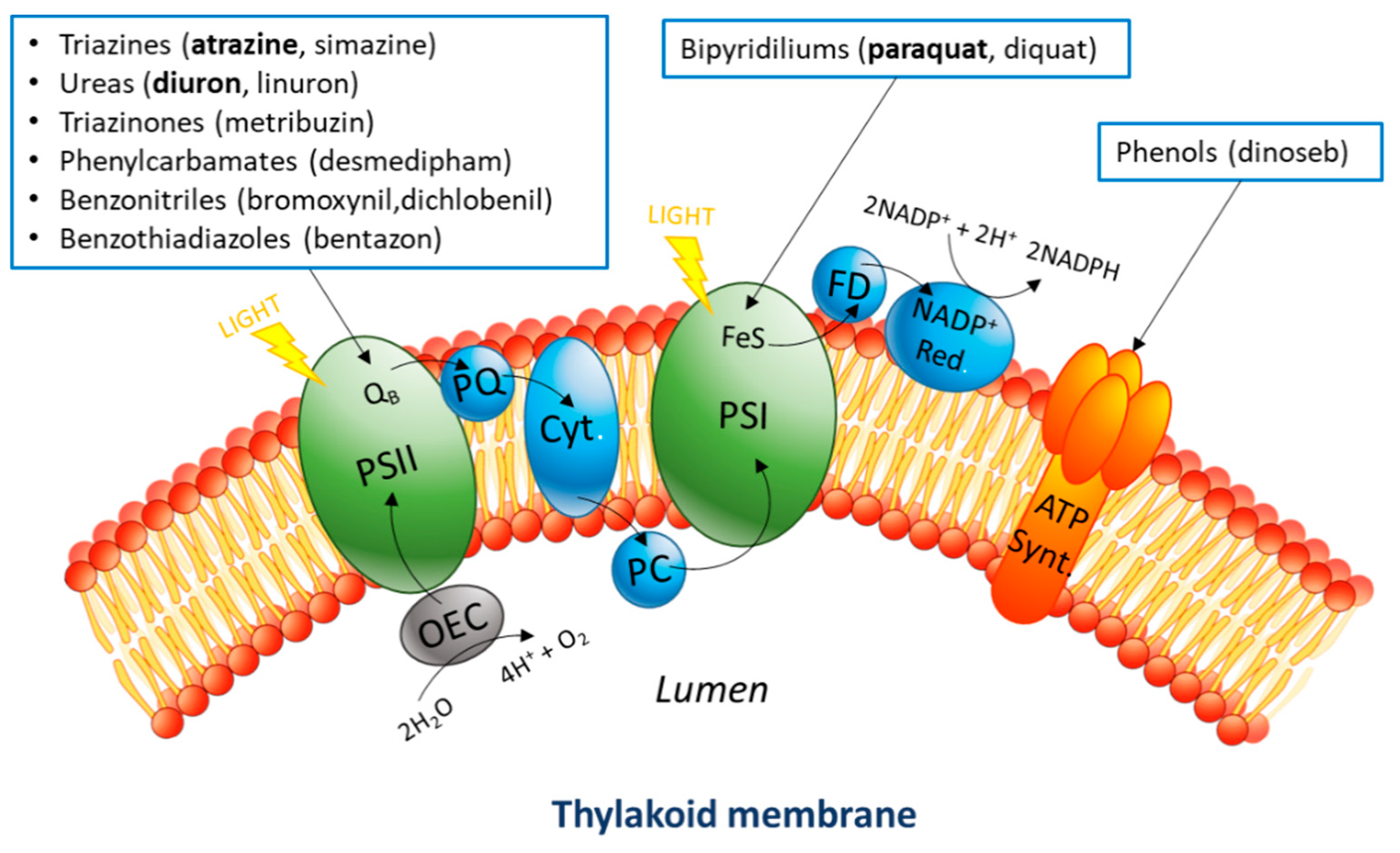
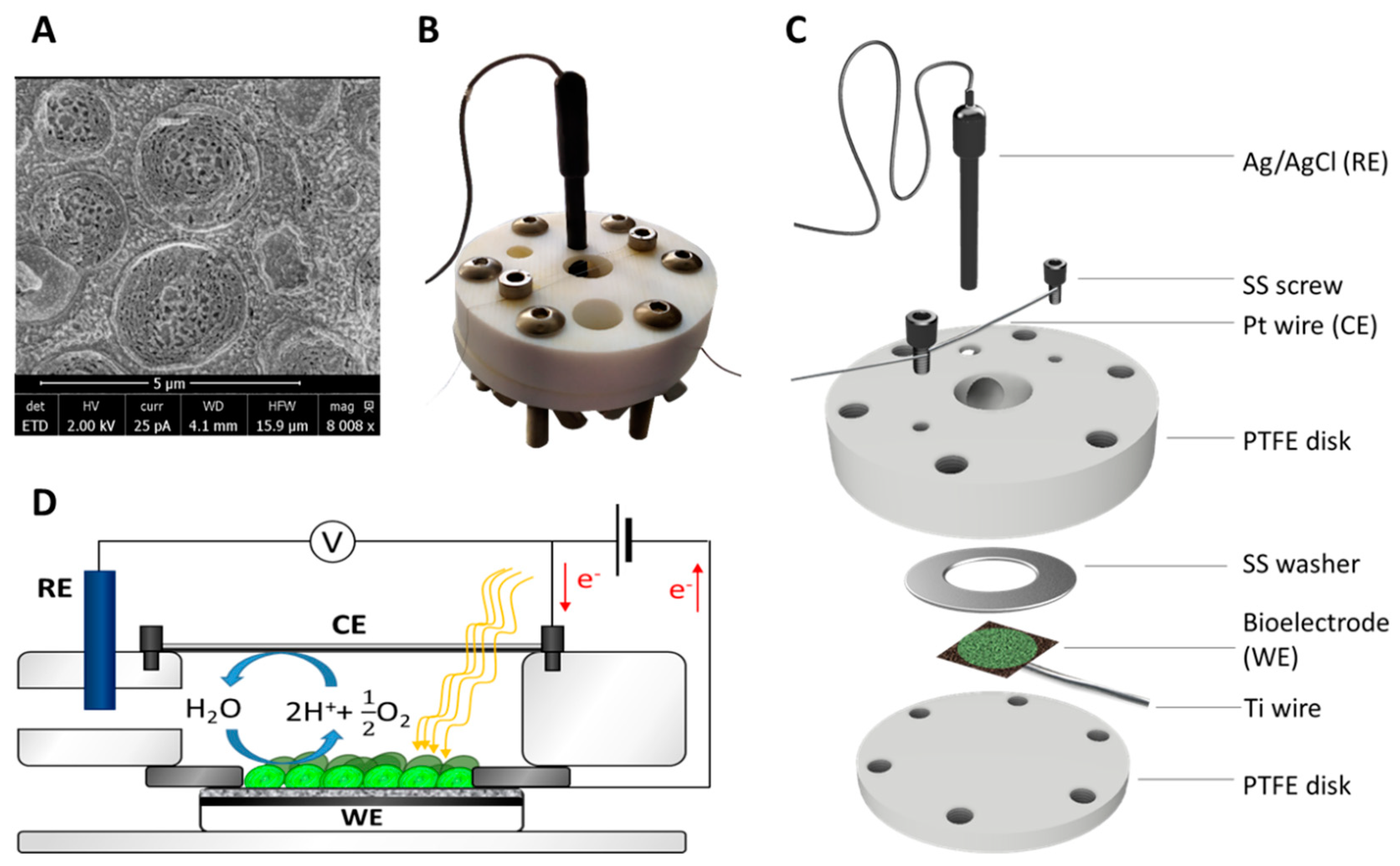
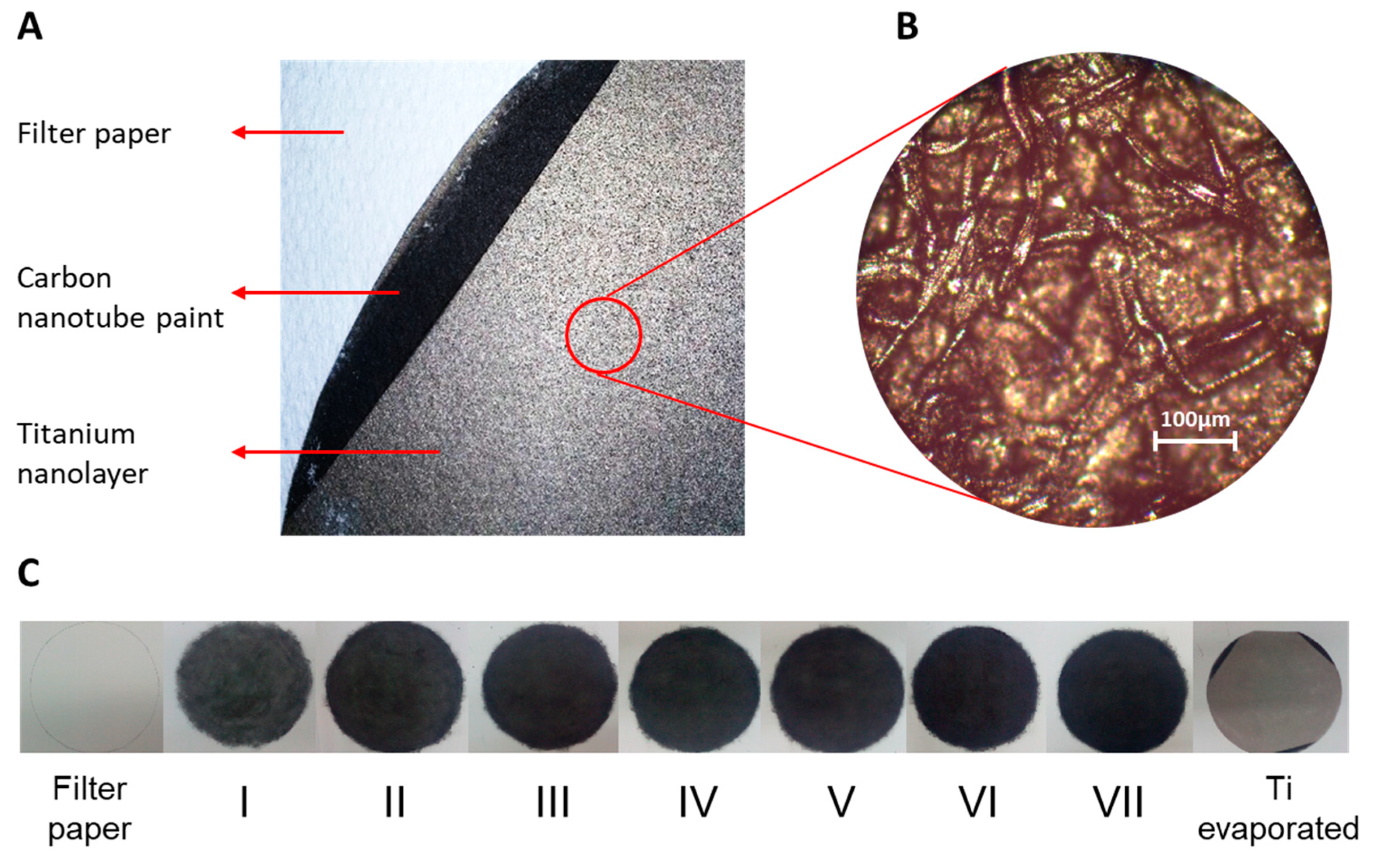

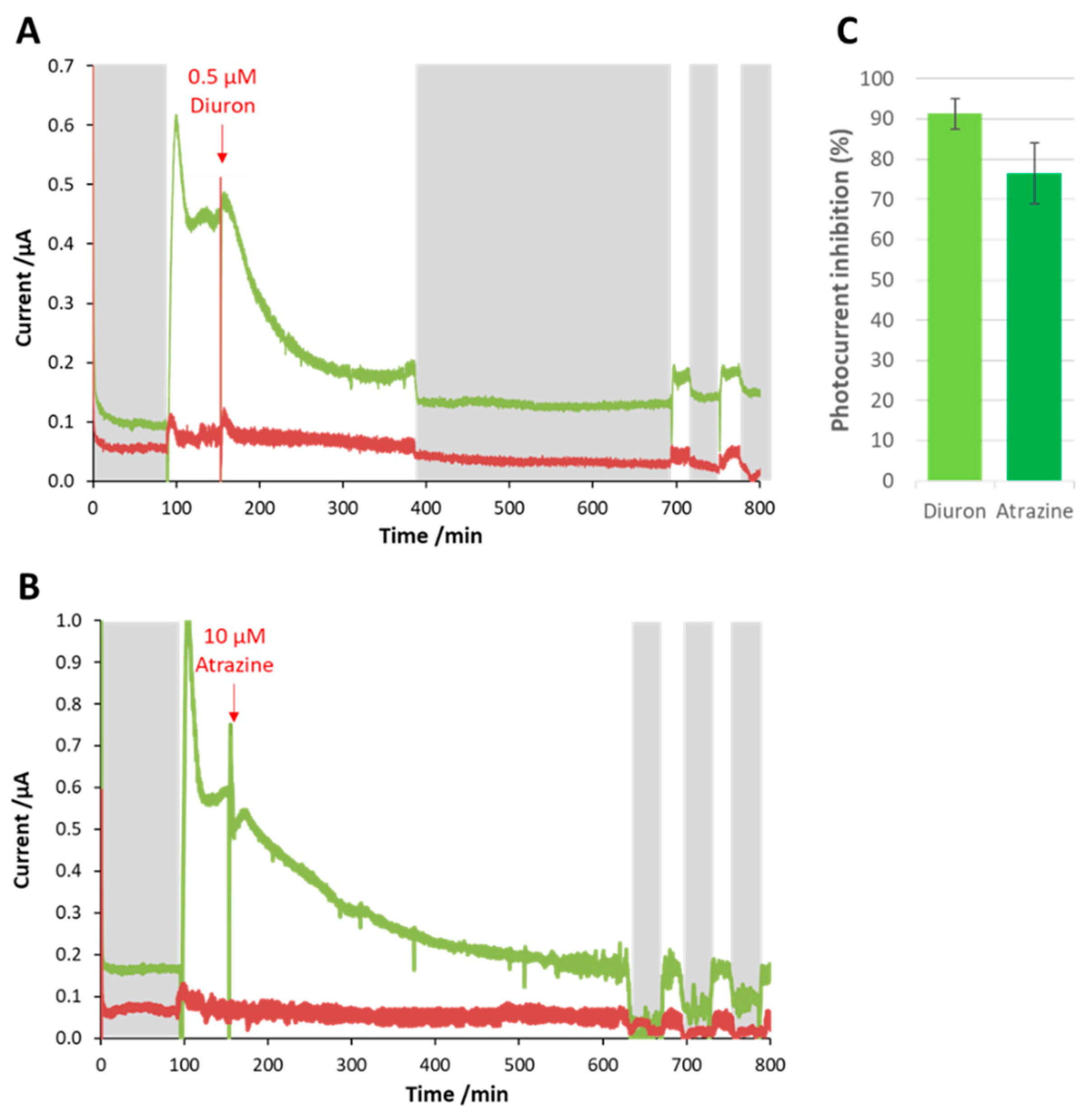
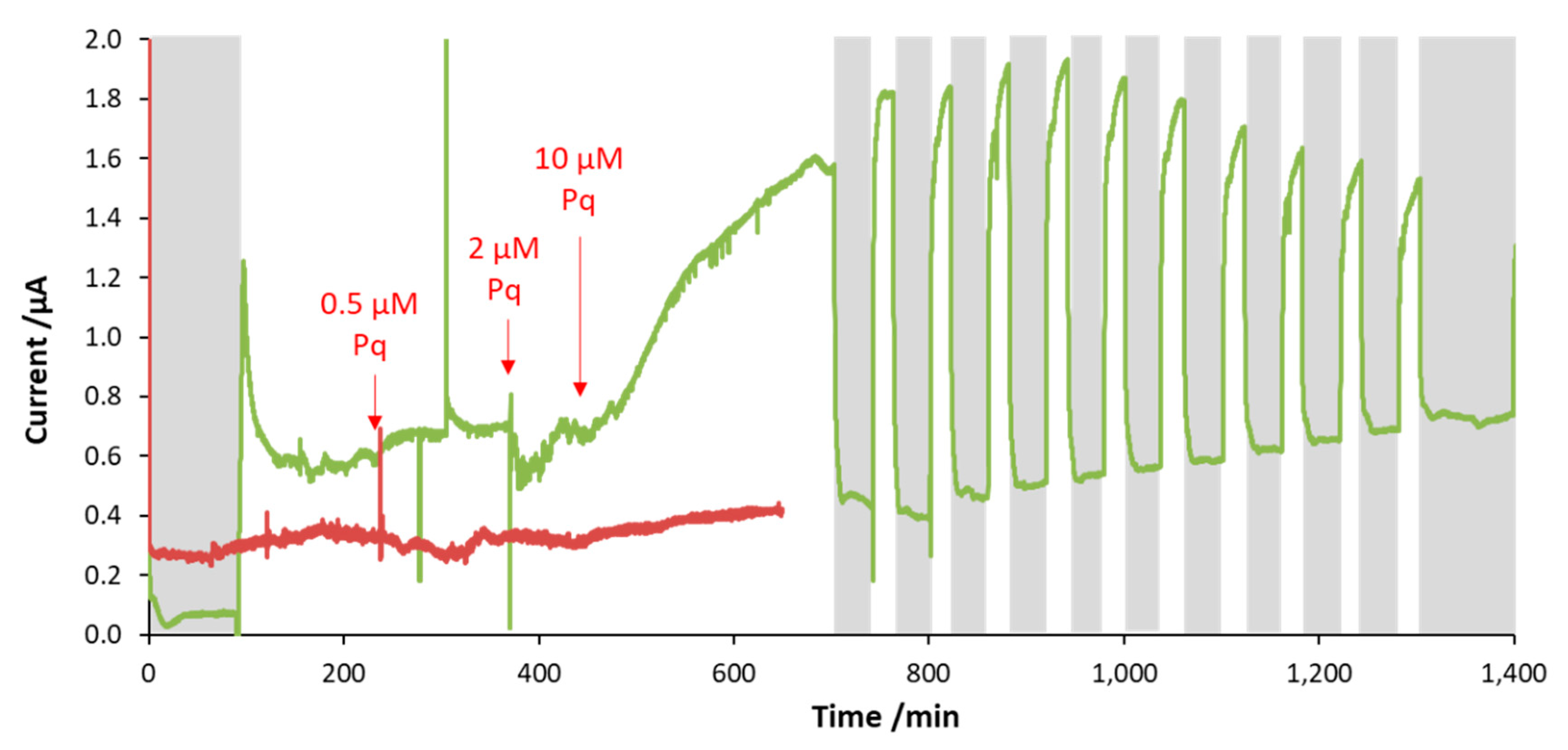
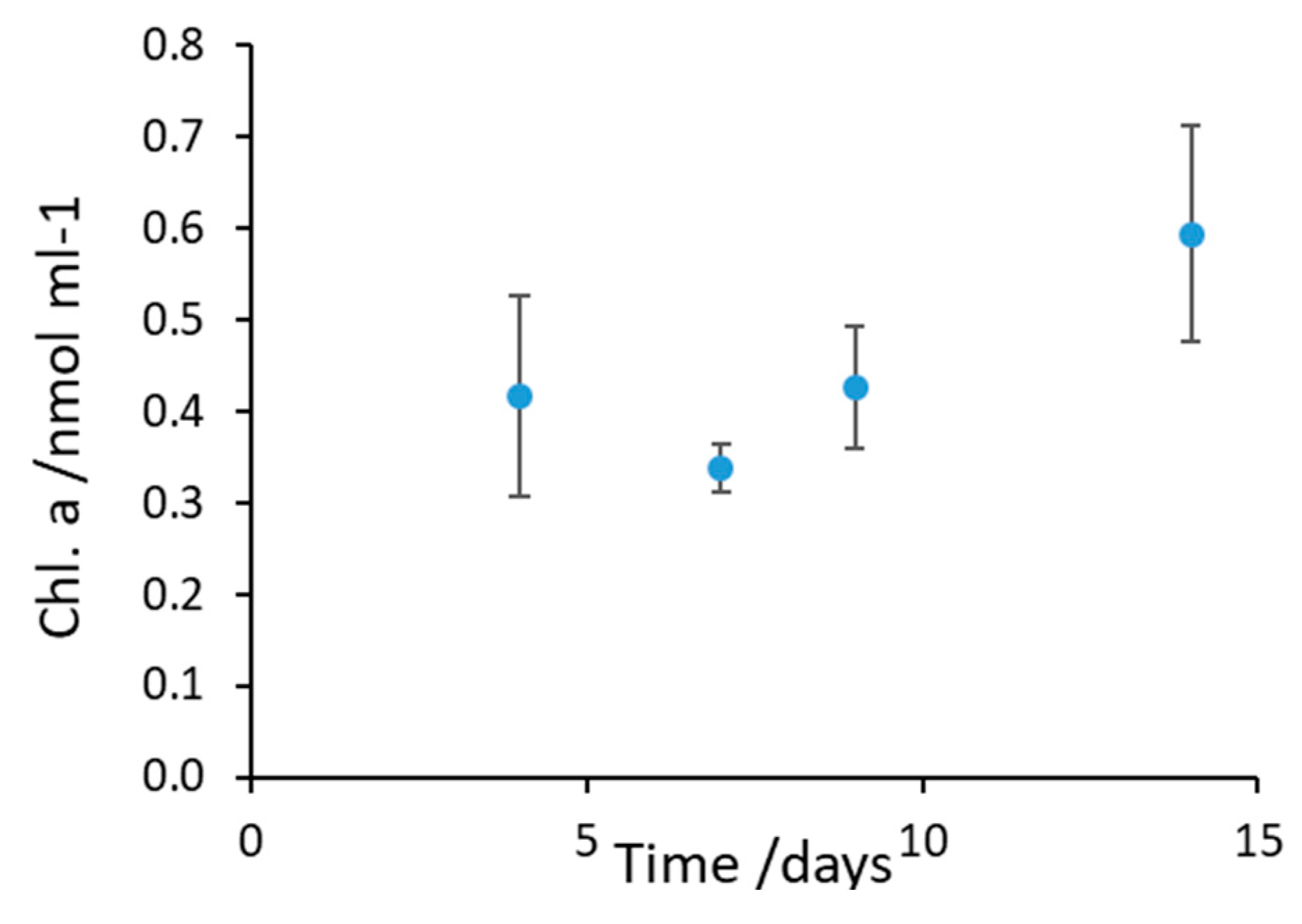
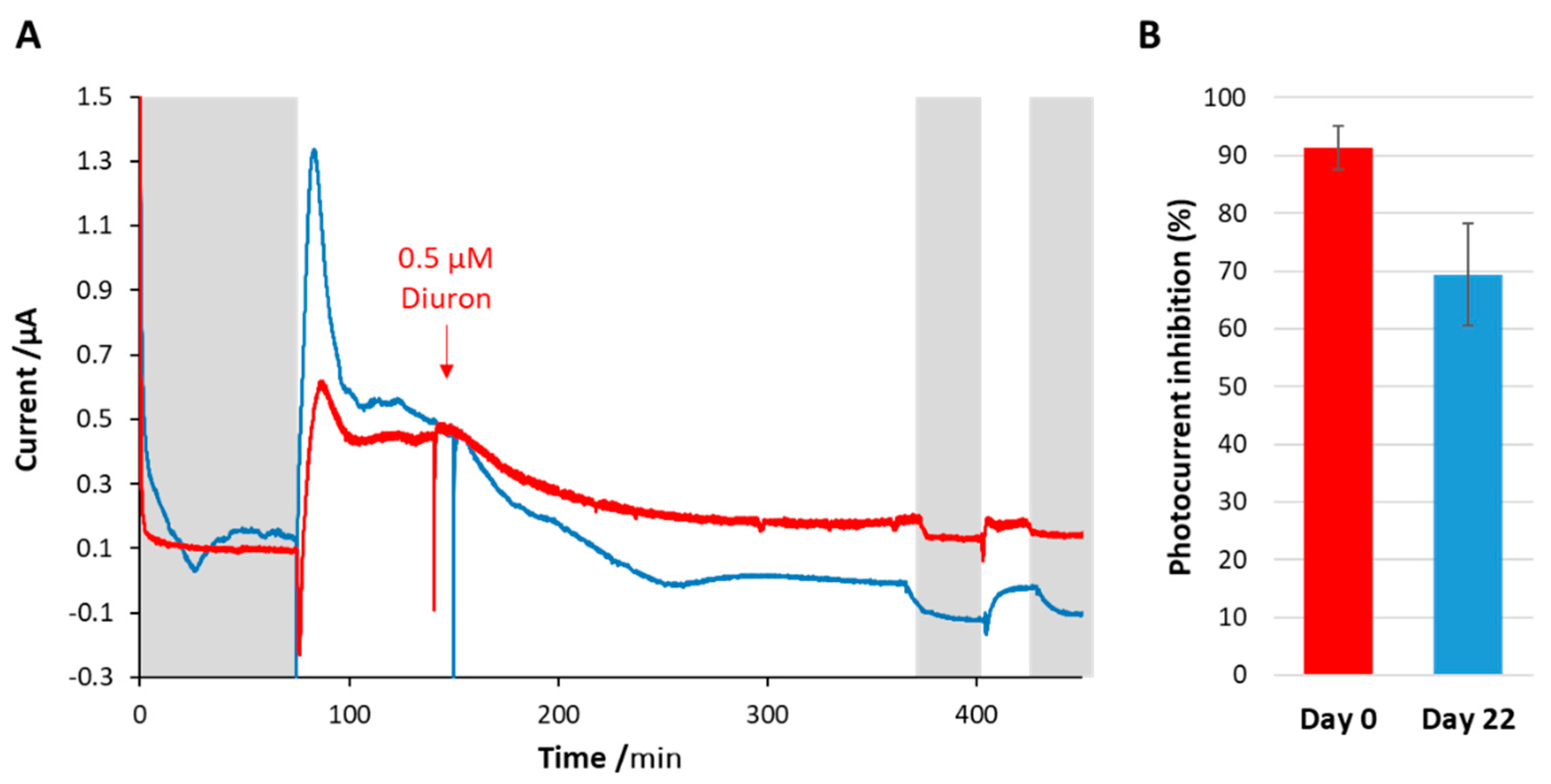
| Bioreceptor | Storage Conditions | Storage Time (days) | Loss of Sensitivity (%) | Reference |
|---|---|---|---|---|
| Chlorella vulgaris | 4 °C in CaCl2 solution | 30 | 20 | Shitanda et al., 2009 [37] |
| Chlorella vulgaris | 4 °C in Tris-HCl + MgCl2 | 10 | 45 | Ionescu et al., 2006 [34] |
| Chlamydomonas reinhardtii | 25 °C in storage buffer, light | 25 | 40 | Husu et al., 2013 [40] |
| Synechocystis 6803 wt. | 4 °C in BG11 medium, dark | 22 | 22 | Present study |
| Photocurrent Variation (%) | Concentration Used (μM) | Acute Exposure for Fish (μM) | |
|---|---|---|---|
| Atrazine | −76 ± 7 | 10.7 | 12.3 |
| Diuron | −91 ± 4 | 0.5 | 0.9 |
| Paraquat | +203 ± 3 | 0.7 | 23.3 |
© 2019 by the authors. Licensee MDPI, Basel, Switzerland. This article is an open access article distributed under the terms and conditions of the Creative Commons Attribution (CC BY) license (http://creativecommons.org/licenses/by/4.0/).
Share and Cite
Tucci, M.; Bombelli, P.; Howe, C.J.; Vignolini, S.; Bocchi, S.; Schievano, A. A Storable Mediatorless Electrochemical Biosensor for Herbicide Detection. Microorganisms 2019, 7, 630. https://doi.org/10.3390/microorganisms7120630
Tucci M, Bombelli P, Howe CJ, Vignolini S, Bocchi S, Schievano A. A Storable Mediatorless Electrochemical Biosensor for Herbicide Detection. Microorganisms. 2019; 7(12):630. https://doi.org/10.3390/microorganisms7120630
Chicago/Turabian StyleTucci, Matteo, Paolo Bombelli, Christopher J. Howe, Silvia Vignolini, Stefano Bocchi, and Andrea Schievano. 2019. "A Storable Mediatorless Electrochemical Biosensor for Herbicide Detection" Microorganisms 7, no. 12: 630. https://doi.org/10.3390/microorganisms7120630
APA StyleTucci, M., Bombelli, P., Howe, C. J., Vignolini, S., Bocchi, S., & Schievano, A. (2019). A Storable Mediatorless Electrochemical Biosensor for Herbicide Detection. Microorganisms, 7(12), 630. https://doi.org/10.3390/microorganisms7120630





